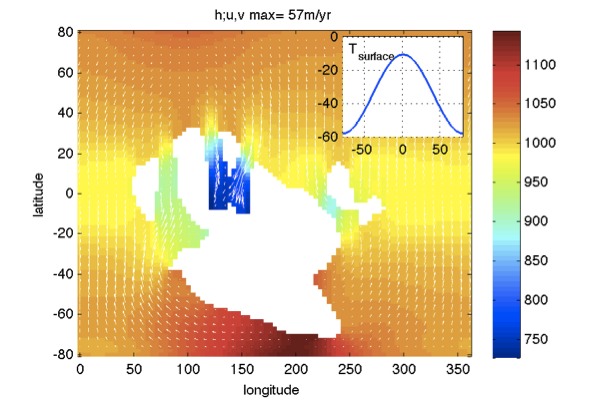Cryosphere
Back to main research page
Ice is a fascinating fluid, obeying non-Newtonian, highly nonlinear dynamics. We have done work on the dynamics of sea ice (typically 1–2 meters thick) and of land ice and ice shelves (hundreds of meters to kilometers thick).
Sea ice (with Chris Horvat)
Sea ice is composed of floes whose size varies from centimeters to hundreds of km. Climate models cannot simulate individual floes and including their dynamics requires instead a representation of their statistical distribution. We developed the first model for the evolution of the joint sea-ice floe size and thickness distribution that includes the interactions with the ocean and atmosphere, accounting for freezing, melting, mechanical interactions due to floe collisions (ridging and rafting), and sea-ice fracture due to wave propagation (Horvat and Tziperman
2015,
2017,
2018, Horvat et al
2016). Thanks to Chris's later work, the model was implemented into global climate models, improving their representation of sea ice.
Land ice/ glaciology:
Understanding land ice flow is important to a number of climate related problems, from how the ice sheets of the last glacial maximum (21kyr ago) retreated, to the dynamics of Greenland and Antarctica in a global warming scenario.
Ice streams and deglaciation (with Alex Robel)
At the end of the last glacial maximum, 15–21 kyr ago, the Laurentide ice sheet that covered much of northern north America disappeared remarkably fast, within a few thousands of years. This is often attributed to Milankovitch forcing, but the ice sheet has seen several Milankovitch cycles and it is not clear why this last one was so effective. We propose that when an ice sheet is large, with ice streams fully developed, it is more sensitive to collapse, and that ice stream acceleration driven by Milankovitch forcing, is the mechanism for the initial collapse, before additional climate feedbacks kick in and amplify the warming and melting (
Robel and Tziperman, 2016).
Ice streams and multi-valued sliding laws (with Roiy Sayag)
We attempted to study the dynamics of ice streams, which are narrow (20–50km) and rapid (1km/year, about 1000 times faster than surrounding ice) jet-like features seen, for example, in the Siple-coast of Antarctica. These streams seem to spontaneously evolve in time and space, and their dynamics are not yet completely understood.
Roiy showed that the spatial structure of ice streams implies that the basal stress felt by the ice flow is a non-monotonous function of the basal sliding velocity. That is, as the siding velocity increases, the stress initially increases, then decreases (possibly due to the formation of melt water at the base due to the frictional heating), and then increases again. Such multi-valued sliding laws are known to produce interesting temporal behaviors such as relaxation oscillations and we saw them to also induce complicated spatio-temporal ice stream variability, ice stream merging and separation, etc. [
1,
2].
Ice flow over a Snowball-Earth ocean (with Yossi Ashkenazy)
It has been pointed out in previous studies that when the ocean is completely ice cover during a Snowball-Earth event, ice thickness gradients can induce ice flow from thick to thin ice, therefore acting as an efficient thickness-homogenization feedback. These studies used one-dimensional models, considering the ice thickness and flow as function of latitude alone. We have considered the thickness and flow of ice in both latitude and longitude, and including the effects of continents. We showed that some areas, where the ice flow is constricted by continents, strong thickness gradients may develop. Such thickness gradients are important to the understanding of the survival of photosynthetic life during a snowball event.
[1].

Ice thickness and flow field in a Snowball Earth scenario, with a reconstructed continental configuration corresponding to 630 Myr ago.
Europa's ocean and ice dynamics (with Yossi Ashkenazy)
Europa, the icy moon of Jupiter, is believed to have a 100 km deep global ocean, covered by a 10–20 km deep icy shell. We have examined the global ice flow of this icy shell (~20 km thick,
Ashkenazy, Sayag, Tziperman, 2018), explored for the first time the effects on its ocean circulation of salinity and of proper thermal boundary conditions at the top and bottom of this ocean (
Ashkenazy and Tziperman, 2021). In particular, we studied the interaction between the ocean and icy shell and the possibly observable non-synchronous rotation of the icy shell induced by zonal ocean jets (
Ashkenazy, Tziperman, and Nimmo, 2023).


